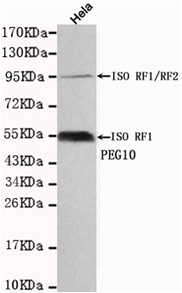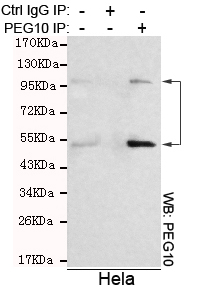PEG10 Antibody
Purified Mouse Monoclonal Antibody (Mab)
- 产品详情
- 实验流程
- 背景知识
| Primary Accession | Q86TG7 |
|---|---|
| Host | Mouse |
| Clonality | Monoclonal |
| Isotype | IgG1 |
| Calculated MW | 80173 Da |
| Gene ID | 23089 |
|---|---|
| Other Names | AA407948;Edr;Embryonal carcinoma differentiation regulated;Embryonal carcinoma differentiation-regulated protein;HB 1;HB1;KIAA1051;Mammalian retrotransposon-derived protein 2;Mar2;Mart2;MEF3 like 1;MEF3-like protein 1;MEF3L;MEF3L1;MyEF 3;Myelin expression factor 3-like protein 1;Paternally expressed 10;Paternally expressed gene 10 ORF1;Paternally expressed gene 10 protein;Peg10;PEG10 protein;PEG10_HUMAN;Putative uncharacterized protein PEG10;Retrotransposon gag domain containing 3;Retrotransposon gag domain-containing protein 3;Retrotransposon-derived gag-like polyprotein; Retrotransposon-derived protein PEG10;RGAG3;Ty3/Gypsy-like protein. |
| Format | Purified mouse monoclonal in buffer containing 0.1M Tris-Glycine (pH 7.4, 150 mM NaCl) with 0.09% (W/V) sodium azide, 50%,glycerol |
| Storage | Store at -20 °C.Stable for 12 months from date of receipt |
| Name | PEG10 {ECO:0000303|PubMed:11318613, ECO:0000312|HGNC:HGNC:14005} |
|---|---|
| Function | Retrotransposon-derived protein that binds its own mRNA and self-assembles into virion-like capsids (PubMed:34413232). Forms virion-like extracellular vesicles that encapsulate their own mRNA and are released from cells, enabling intercellular transfer of PEG10 mRNA (PubMed:34413232). Binds its own mRNA in the 5'-UTR region, in the region near the boundary between the nucleocapsid (NC) and protease (PRO) coding sequences and in the beginning of the 3'-UTR region (PubMed:34413232). Involved in placenta formation: required for trophoblast stem cells differentiation (By similarity). Involved at the immediate early stage of adipocyte differentiation (By similarity). Overexpressed in many cancers and enhances tumor progression: promotes cell proliferation by driving cell cycle progression from G0/G1 (PubMed:12810624, PubMed:16423995, PubMed:26235627, PubMed:28193232). Enhances cancer progression by inhibiting the TGF-beta signaling, possibly via interaction with the TGF-beta receptor ACVRL1 (PubMed:15611116, PubMed:26235627, PubMed:30094509). May bind to the 5'-GCCTGTCTTT-3' DNA sequence of the MB1 domain in the myelin basic protein (MBP) promoter; additional evidences are however required to confirm this result (By similarity). |
| Cellular Location | Extracellular vesicle membrane. Cytoplasm. Nucleus Note=Forms virion-like extracellular vesicles that are released from cells (PubMed:34413232). Detected predominantly in the cytoplasm of breast and prostate carcinomas, in hepatocellular carcinoma (HCC) and B-cell chronic lymphocytic leukemia (B-CLL) cells and in the Hep-G2 cell line (PubMed:12810624). |
| Tissue Location | Expressed in the cytotrophoblast layer but not in the overlying syncytiotrophoblast of the placenta. Expressed in prostate and breast carcinomas but not in normal breast and prostate epithelial cells. Expressed in the Hep-G2 cell line (at protein level) Expressed in brain, liver, spleen, kidney, thymus, lung, ovary, testis, reactive lymph node, skeletal muscle, adipose tissue and placenta Expressed in pancreatic and hepatocellular carcinomas (HCC) |
For Research Use Only. Not For Use In Diagnostic Procedures.
Provided below are standard protocols that you may find useful for product applications.
BACKGROUND
Prevents apoptosis in hepatocellular carcinoma (HCC) cells through interaction with SIAH1, a mediator of apoptosis. May also have a role in cell growth promotion and hepatoma formation. Inhibits the TGF-beta signaling by interacting with the TGF-beta receptor ALK1. When overexpressed, induces the formation of cellular extension, such as filipodia in association with ALK1. Involved at the immediate early stage of adipocyte differentiation (By similarity). May bind to the 5'-GCCTGTCTTT-3' DNA sequence of the MB1 domain in the myelin basic protein (MBP) promoter (By similarity).
REFERENCES
Ono R.,et al.Genomics 73:232-237(2001).
Nagase T.,et al.DNA Res. 6:63-70(1999).
Ohara O.,et al.Submitted (JUN-1999) to the EMBL/GenBank/DDBJ databases.
Satoh S.,et al.Submitted (SEP-2002) to the EMBL/GenBank/DDBJ databases.
Hillier L.W.,et al.Nature 424:157-164(2003).
终于等到您。ABCEPTA(百远生物)抗体产品。
点击下方“我要评价 ”按钮提交您的反馈信息,您的反馈和评价是我们最宝贵的财富之一,
我们将在1-3个工作日内处理您的反馈信息。
如有疑问,联系:0512-88856768 tech-china@abcepta.com.























 癌症的基本特征包括细胞增殖、血管生成、迁移、凋亡逃避机制和细胞永生等。找到癌症发生过程中这些通路的关键标记物和对应的抗体用于检测至关重要。
癌症的基本特征包括细胞增殖、血管生成、迁移、凋亡逃避机制和细胞永生等。找到癌症发生过程中这些通路的关键标记物和对应的抗体用于检测至关重要。 为您推荐一个泛素化位点预测神器——泛素化分析工具,可以为您的蛋白的泛素化位点作出预测和评分。
为您推荐一个泛素化位点预测神器——泛素化分析工具,可以为您的蛋白的泛素化位点作出预测和评分。 细胞自噬受体图形绘图工具为你的蛋白的细胞受体结合位点作出预测和评分,识别结合到自噬通路中的蛋白是非常重要的,便于让我们理解自噬在正常生理、病理过程中的作用,如发育、细胞分化、神经退化性疾病、压力条件下、感染和癌症。
细胞自噬受体图形绘图工具为你的蛋白的细胞受体结合位点作出预测和评分,识别结合到自噬通路中的蛋白是非常重要的,便于让我们理解自噬在正常生理、病理过程中的作用,如发育、细胞分化、神经退化性疾病、压力条件下、感染和癌症。







